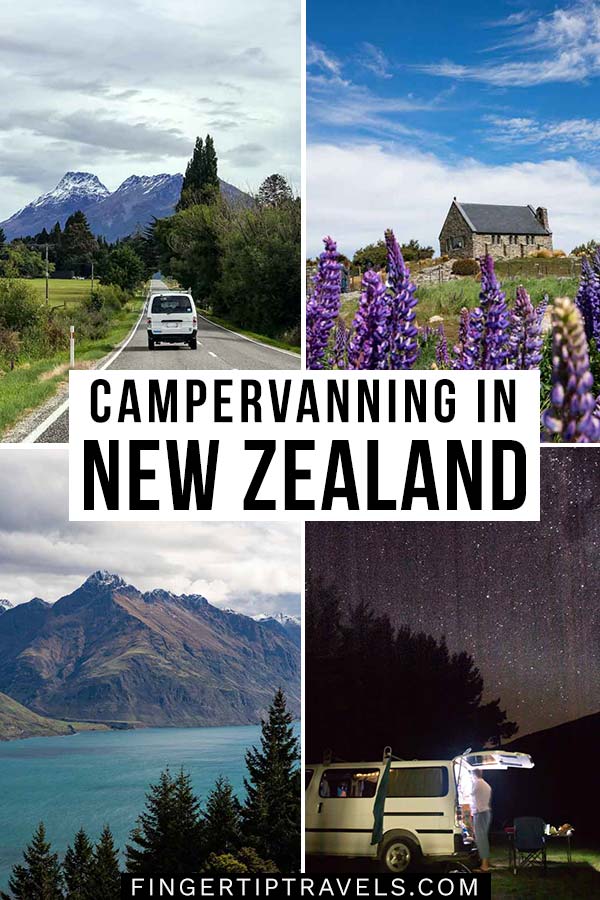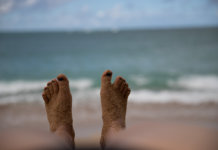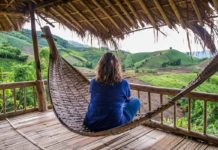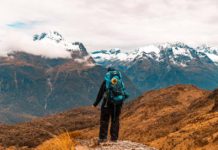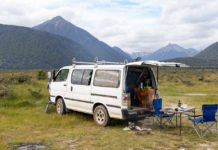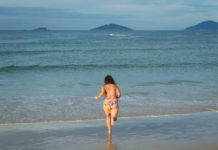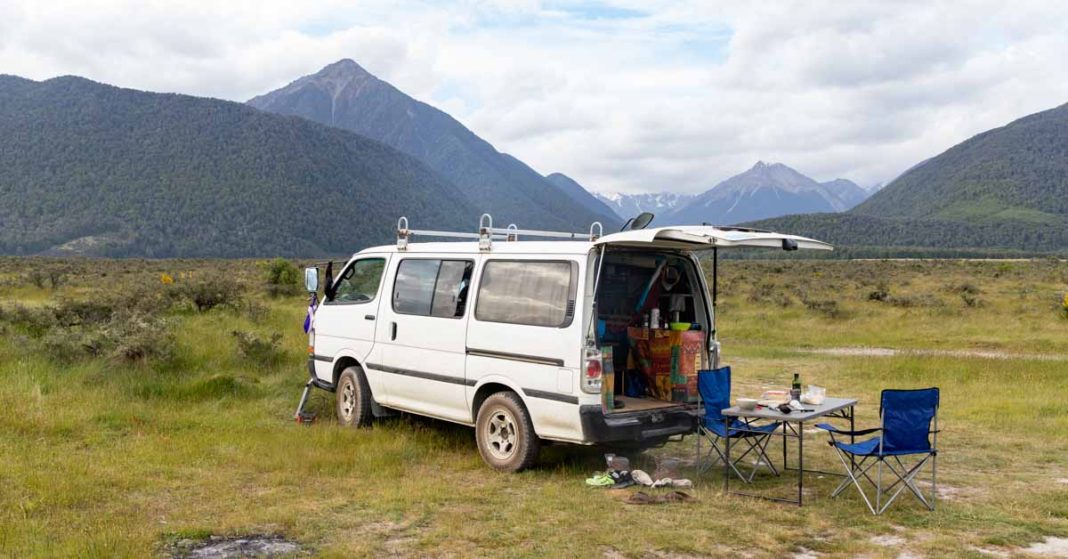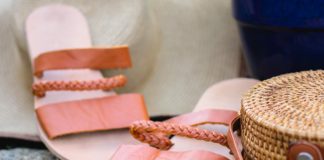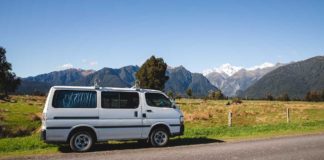Traveling New Zealand by campervan was an adventurous, transformational, free spirited, and laid-back road trip through some of the most beautiful landscape I’ve ever seen. It’s a truly bucket-list worthy adventure, and it’s changed the way I think about my future travels. I want all my future globe-trotting to inspire me the way New Zealand van life has.
My fiance and I lived in our campervan for seven months of the year that we spent in New Zealand. There was a steep learning curve to living in such a small, mobile space, and taking care of all of the logistics on the road. In this blog post I’ll discuss everything you need to know to campervan around New Zealand. I’ll go over campervan basics, getting a campervan, and all the logistics of New Zealand van life: sleeping, showering, eating, water systems, and more. I’ll conclude with some campervan tips: all the practical and cozy things we learned from campervanning in New Zealand.
Table of Contents
Why Campervanning New Zealand is Awesome!
In case you’re skeptical, or just for inspiration or wanderlust, below are some of the reasons to go campervanning in New Zealand.

- A campervan is like a cozy home that you take everywhere with you! You can go on epic adventures and come back to a safe, comfy, inviting, tiny house that you don’t need to set up or check into. You’re already unpacked, and all of your favorite things are there. It’s also full of food. YES!!!
- You don’t need to pack your backpack every time you go to a new destination! This is huge!! As much as I love backpacking, packing my backpack every time I travel to a new hostel is a chore. In a campervan, you can literally roll out of bed and travel to your next destination in your pajamas, not even making the bed if you don’t feel like it.
- Campervanning in New Zealand is incredibly popular, which means that there are heaps of facilities and tools to make it easy.
- It’s also incredibly safe. New Zealand in general is a very safe country to travel in, and taking safety out of the ‘to-worry-about’ list is really refreshing.
- Campervanning in New Zealand is also affordable. New Zealand isn’t the cheapest country to travel in, but your campervan budget covers some lodging and transportation, as well as making it easier to cook your own food. Personally, we saved a bunch of money by traveling and living in our van.
- It facilitates off-the-beaten-track adventures! Not only is it easier to get to less touristy areas, some freedom camping locations that we stayed in were in out of the way destinations. It was fun to explore those more remote locations.
- Campervanning lets you be spontaneous! Since you have everything you need with you, and you aren’t beholden to bus schedules, you can decide last minute to spend extra time on the secluded beach you found, or to drive into the mountains for a scenic breakfast.
- Living in a campervan gives you confidence! It’s very empowering to travel knowing that you can meet all of your basic needs through systems and methods that you’re in charge of. Renting, or especially buying, a vehicle and setting off on the road in a foreign country is intimidating, and surmounting that obstacle is an experience that engenders self-confidence.
Campervan Basics
What is a Campervan?
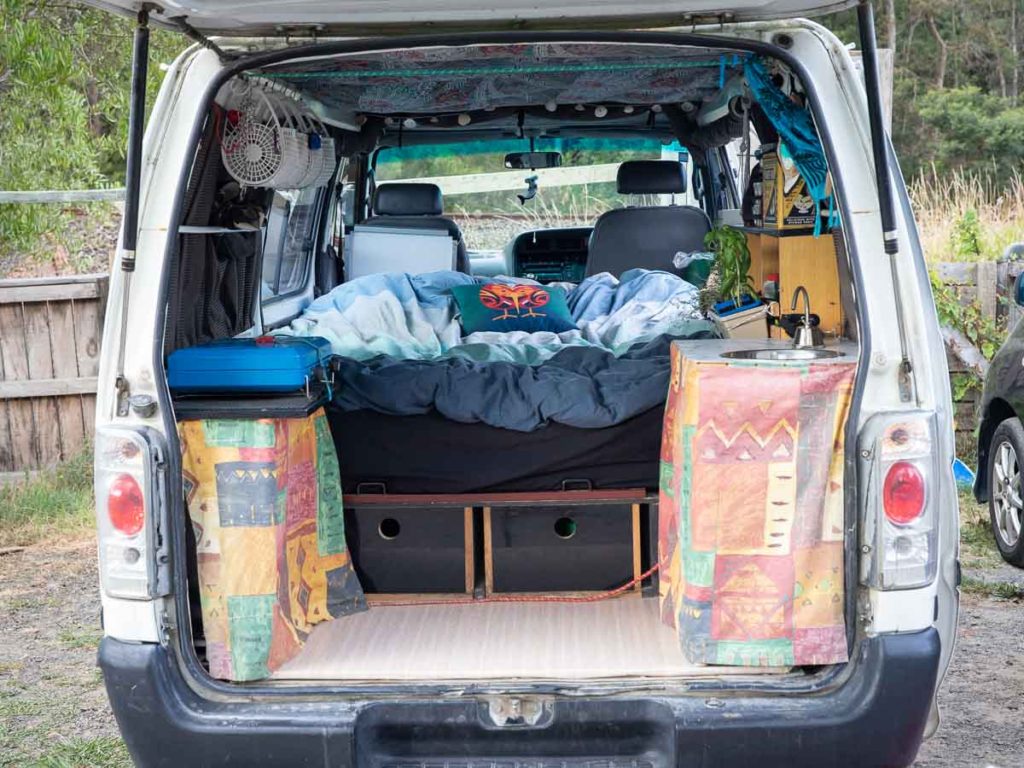
A campervan is a vehicle fitted out with sleeping accommodations. It’s made to explore, and is functional for both transportation and living in. Campervans come in all shapes and sizes: from very basic setups for minimalist spartans, to beasts of comfort and elegance.
The kind of campervan you get depends a lot on your preferences and budget. Our van was a Toyota Hiace outfitted with a bed, storage drawers and shelves, a kitchen, and a sink. It was very convenient and had everything we needed. Some campervans have showers, living areas, and second floor sleeping quarters.
Powered vs Unpowered
Some campervans can be plugged into a power source to charge up their power bank, which is used for lights, a fridge, the sink, etc. Some New Zealand campgrounds for campervans have powered sites, where you can plug in your van. They’ll cost a bit more than unpowered sites.
Should you get a van with this functionality? The short answer is no. Our van was unpowered and we never wished otherwise. This is usually a feature of larger setups, which use a lot more power. Instead, we used a large battery bank with a solar panel charger, which I’ll expand on more below. Other vans have a second car battery that gets charged while driving, that powers the lights and various electronics.
Self-Contained vs Not Self-Contained
A Self-Contained vehicle is one that you can live in for three days without getting more water or dumping any waste. You leave no trace: there’s nothing left behind from where you stayed except an indentation in the grass.
This is an official certification that a vehicle has to obtain after meeting certain requirements. The requirements are:
- A fresh water tank with 12L of water per person
- A grey water tank (waste water) with 12L per person
- A sink connected to the water-tight grey water tank
- A trash can with a lid
- A toilet, 3L per person
The only advantage of a self-contained campervan is that you can freedom camp: camp for free on some public land. To us, this advantage was huge, and absolutely worth it. If you’re mostly planning to stay in campgrounds and other payed locations, there’s no need for a self-contained campervan.
Buying vs Renting a Campervan
There are two option for getting a campervan in New Zealand: renting or buying.
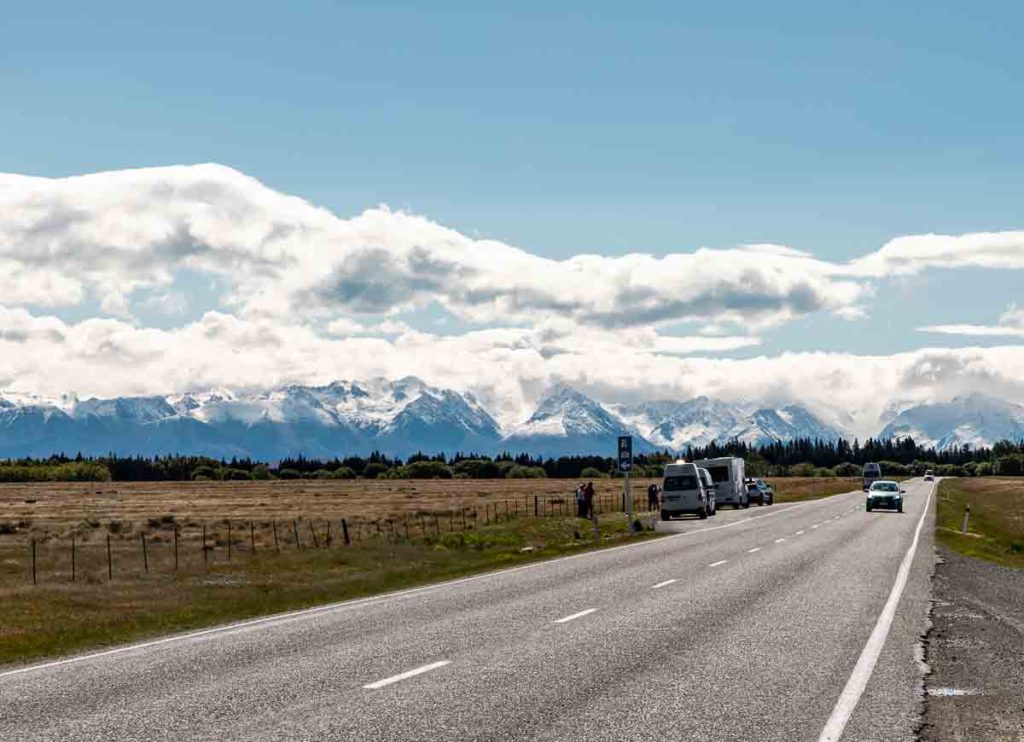
We bought a campervan, and for us it was a really good decision. I have a post where I go into details about how to buy a campervan in New Zealand: check it out here. I discuss where to find listings, what certifications you need, the pre purchase inspection, how to pay someone, car insurance, and much much more. All the nitty gritty details.
Should you rent or buy a campervan? There are many factors to consider, the most important being cost, time, and risk.
Cost of Buying vs Renting a Campervan
First let’s see how much it costs to buy a campervan in New Zealand. Below is what we spent on our campervan during our year in New Zealand, and what we sold it for.
| Cost of Owning a Campervan for 1 Year | Cost (USD) |
|---|---|
| Buy Campervan | $4600 |
| Car Insurance | $210 |
| Repairs | $300 |
| 6 month checkup | $135 |
| New WOF + Rego | $120 |
| New Battery | $140 |
| New Tires | $530 |
| Solar Panel + Battery Bank Upgrade | $220 |
| New WOF | $35 |
| Pre purchase inspection | $75 |
| Repairs | $1080 |
| Sell Campervan | – $4200 |
| NET Spent on Campervan | $3245 |
The number will obviously be different for everyone, but it cost us $3245 USD to buy a campervan in New Zealand, drive it for a year, and then sell it.
Below is a rough cost analysis of renting vs buying a campervan. Costs obviously vary a bunch, so this is just a very rough idea. For renting, I’m assuming a price of $100 USD per day, which I got from the lower end of the prices quotes in this blog post.
| Trip Length | Rent Campervan | Buy Campervan |
|---|---|---|
| 2 week trip | $1400 USD | $3300 USD |
| 1 month trip | $3000 USD | $3300 USD |
| 1.5 month trip | $4500 USD | $3300 USD |
| 2 month trip | $6000 USD | $3300 USD |
As you can see from the table above, the prices are equivalent at a trip length of about 1 month. Just from a monetary perspective, you should buy a campervan if your trip is over 1 month. However, it’s not that simple.
Quick note on seasonality: Van prices vary dramatically with demand: everybody is buying vans at the beginning of the summer (Dec-Jan), and everybody is selling vans at the end of the summer (March – April). The prices will reflect that (vans cost more Jan, and less starting in March). The prices of rentals also fluctuate with the season.
You must also consider time and risk when making the choice of buying or renting a campervan.
Time of Buying vs Renting a Campervan
You have to consider the time it takes to buy vs rent a campervan. Renting a campervan takes a couple of hours: buying can take a week or more! Selling a campervan also takes at least a week.
We spent a week buying a campervan and a week selling it. In hindsight, however, I’d budget two weeks for selling: one week was not enough time and made for a very stressful experience.
Add at least two weeks of logistics to your itinerary if you’re considering buying a van.
Thus, you should consider buying a van if your trip is a minimum of 1.5 months long. That still means that ⅓ of your time in New Zealand will be spent on logistics. Personally, I’d bump it up to 2 months or more.
Risk of Buying vs Renting a Campervan
You also have to consider risk when deciding wether to buy or to rent a campervan. Renting comes with guarantees of a working vehicle and any needed repairs are covered by the rental company. Your own vehicle comes with no such guarantee, and as you can see from the table above, we spent quite a bit on repairs throughout the year. (For a 2-3 month trip there would likely be less repairs, though).
Buying a vehicle also means that you’re responsible for keeping all legal forms up to date (the WOF and the Rego, more on these here).
Finally, there’s no guarantee that you will sell your van. There are companies that will buy vans from people who failed to sell and have a flight to catch, but they will offer you less than 50% of what you payed, if not much less. They can smell your desperation.
Although we managed to sell our van, it was a stressful, unpleasant last week in New Zealand: not how I’d hoped we’d say goodbye.
All the Logistics of Campervanning in New Zealand
OK, you have a van, and are ready to set out on the road: now what? First, you have to drive the darn thing!
Driving a Campervan in New Zealand
You can drive in New Zealand if (source):
- You have a current foreign drivers licence
- Your licence is in English/ you have an accurate translation
- You don’t have a disqualification or suspension in New Zealand
- You came to New Zealand less than 12 months ago

Driving on the Left: In New Zealand, you drive on the left side of the road. This is intimidating to many travelers, but it’s not that bad! You kind of chant ‘left, left, left’ for a couple of days, and then you get used to it: promise! Actually, now that I’m back in the US, driving on the right side feels off.
One Lane Bridges: One lane bridges are common in New Zealand, and kind of scary the first time you encounter them. Just pay attention to the arrows for who has right of way, and go slowly.
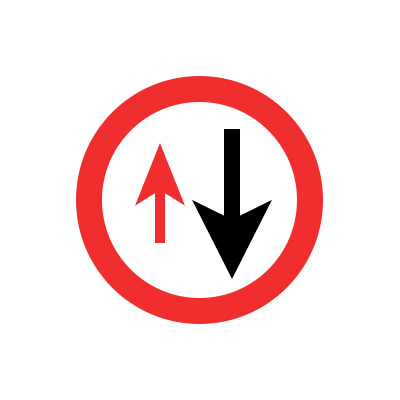
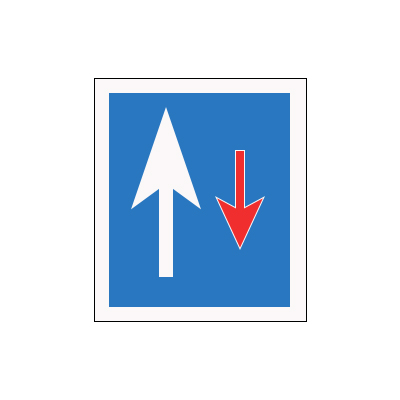
Roundabouts: Roundabouts can also be intimidating, but they are everywhere in New Zealand. I was used to ones in small residential neighborhoods, but New Zealand uses roundabouts on large, multi-lane roads.
- You need to signal if you intend to go left or right on a roundabout.
- Give way to traffic coming from your right.
- At multi-lane roundabouts, get into the correct lane. Turning left: left lane. Going straight: either lane. Turning right: right lane.
Give Way to Faster Vehicles: If someone is faster than you on a one way road (everybody lol), be sure to keep an eye out for pullouts. People are really grateful if you let them past, plus you don’t have someone riding your ass.
New Zealand Roads Take Longer: We always added a generous buffer to the Google Maps estimate.
Where to Stay When Campervanning New Zealand
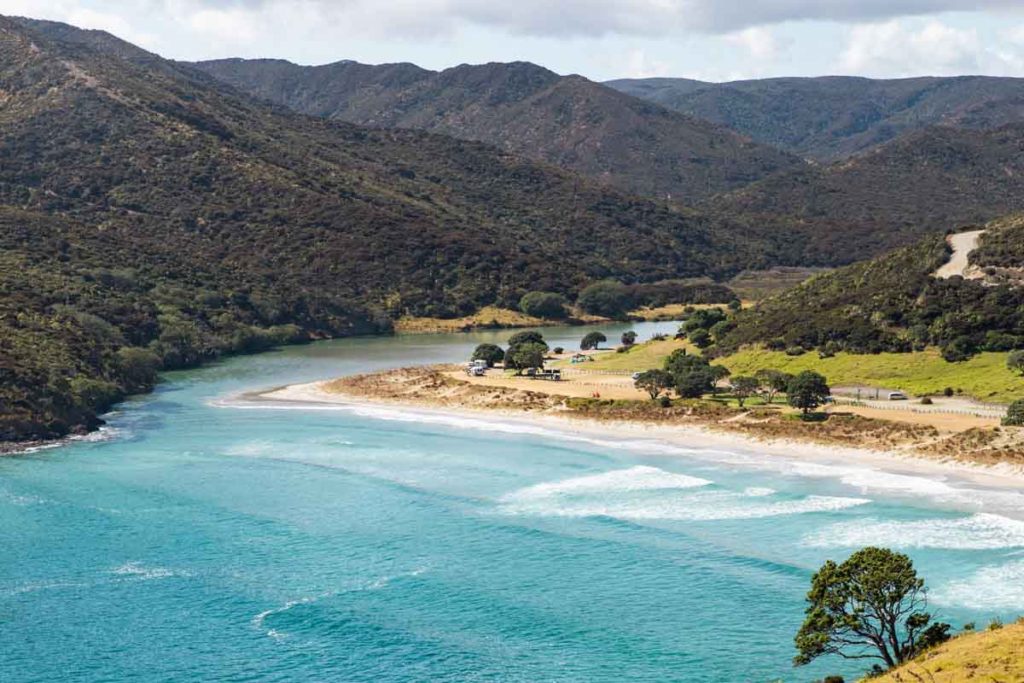
I have a comprehensive New Zealand van camping guide here, where I go into details on the various types of campervan camping in New Zealand, as well as the rules and regulations you need to know.
Briefly, there’s different ‘tiers’ of campgrounds:
- Holiday Parks are campervan campgrounds with all the facilities you need in one complex. There’s bathrooms, hot showers, kitchens, etc. These are the nicest options, and cost about $17-25 NZD per adult.
- DOC Campsites are campsites managed by the Department of Conservation. They tend to be in scenic locations, but have less facilities available. They cost $8-$20 NZD per adult.
- Private Campsites vary in quality, and tend to be $10-$15 NZD per adult.
- Non-Traditional Campsites are places like farms and pubs that offer campervan camping. These are fun, and cost $10-$20 NZD per adult.
- Freedom Camping is my favorite, because it’s free! Some public land is available for self-contained vehicles to camp for free, and I highly recommend this option!
The best way to find campsites is through camping Apps. I talk about the best New Zealand Apps, including three of my favorite camping apps, here. Cliffnotes version: get WikiCamps, Campermate, and Rankers.
Personal Hygiene
Bathrooms: Public bathrooms are very easy to find in New Zealand. Most small towns will have public bathrooms downtown, public parks often have bathrooms, and tourist information centers have bathrooms (i-SITEs). The easiest way to find a bathroom is with the app Campermate.
Showering: Holiday parks and some campgrounds have showers. Many cities have public showers that cost a few dollars to use. Public pools and some parks have showers, and there are often cold outdoor showers on beaches. The best way to find showers is with the app Campermate.
Laundry: Most holiday parks have a laundry room, which is probably the easiest way to do laundry. Every town will have at least one laundromat as well, which you can find through google maps or Campermate.
Campervan Water System
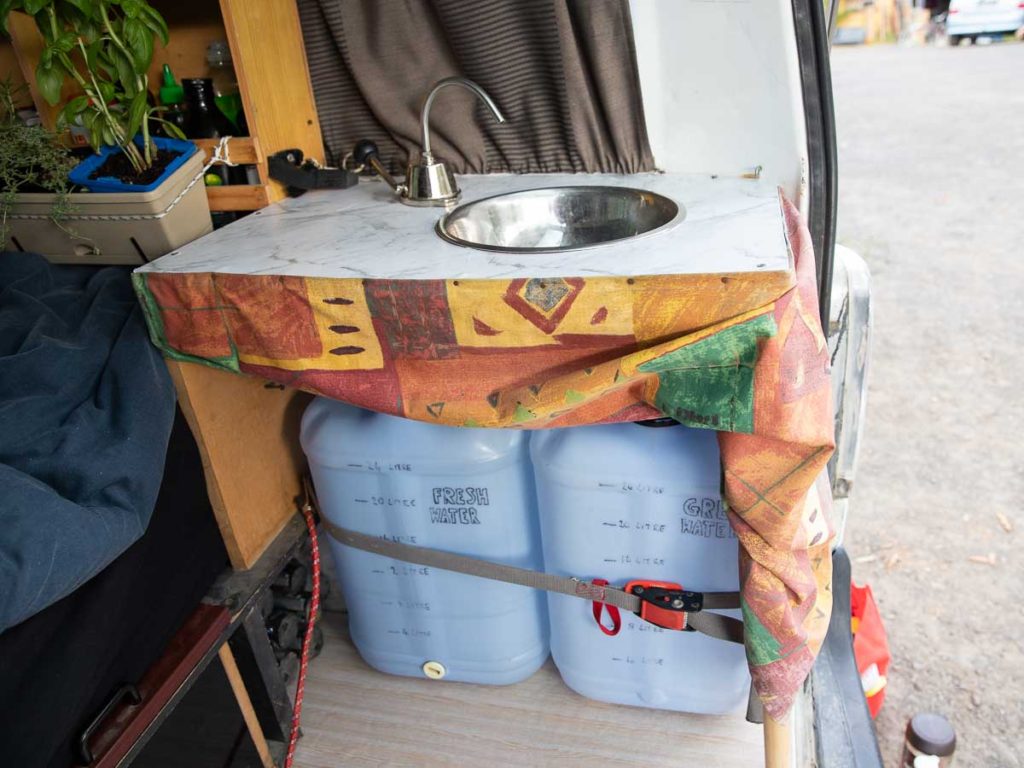
Your campervan should have two tanks: one for clean water, and one for grey water: waste water from what goes down the sink. Every three days or so you’ll have to empty the grey water tank, and fill up your clean water tank.
You can empty your grey water tank at public dump points. The easiest way to find public dump points is through camping apps like WikiCamps or Campermate. Holiday parks will also have a dump point for their customers.
When you empty your tank, make sure to rinse it out with water afterwards. Once there’s some new waste water in there, add a splash of bleach.
For the clean water tank, we liked to always fill it with drinking water. In New Zealand, water will be good for drinking unless indicated otherwise.
What to Eat
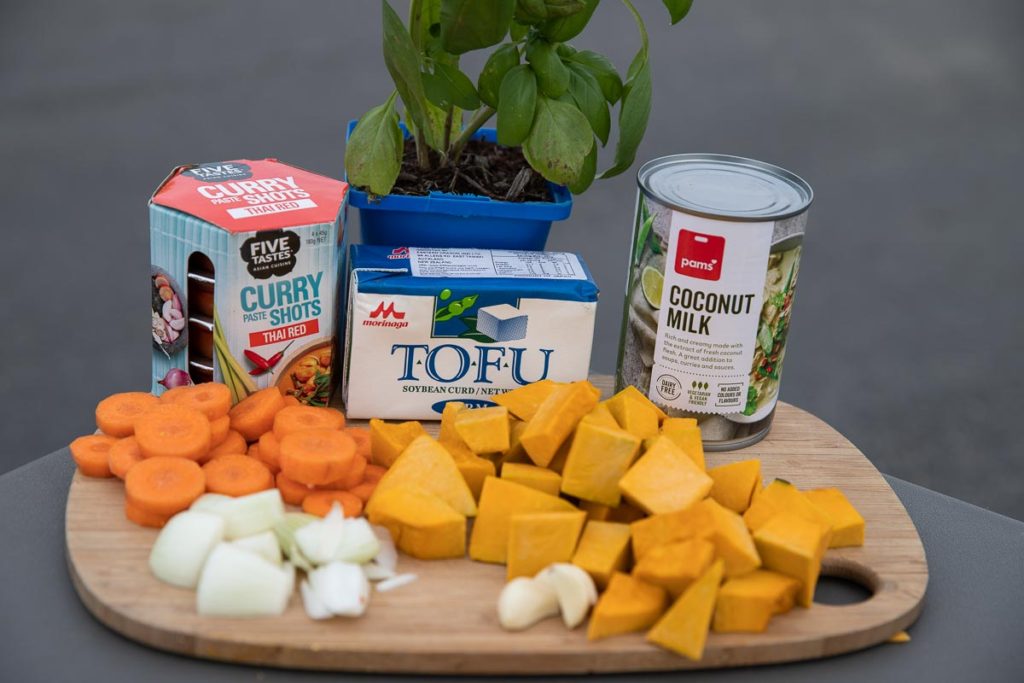
Cooking in a campervan was one of my favorite parts of New Zealand van life. I have a ton of information about campervan cooking here, where I discuss essential ingredients, cooking tips, and provide 9 of my favorite recipes.
In essence, experiment a bunch: you can make a lot more than you think. We ate really well, and it was really fun to explore the different possibilities!
Best Tools for Campervanning New Zealand
The absolute best tools available for campervanning in New Zealand are apps. Here‘s a nine of my favorite New Zealand apps, including driving apps, camping apps, attractions, communications, and more. Since van life is so popular in New Zealand, there’s a wealth of resources available at your disposal.
Campervanning New Zealand in the Winter?
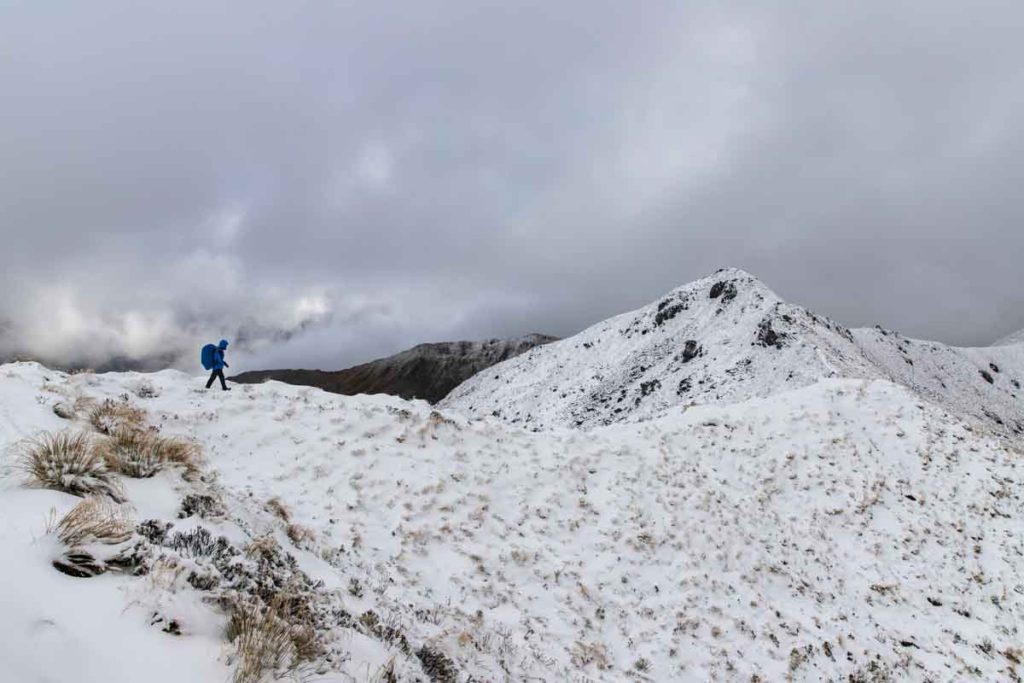
When we started looking for work at the end of the fall, we were still living in our van, and it was a bit rough. It wasn’t as much the cold or the rain, although they were certainly challenges. The hardest part was how early the sun set! We kind of ended up just chilling in the van for hours in the evenings. After a week we got a room in a house and everything got so much better.
So is it possible? Definitely, and people do it. I just personally wouldn’t recommend it.
Campervanning New Zealand Tips
General Campervan Tips
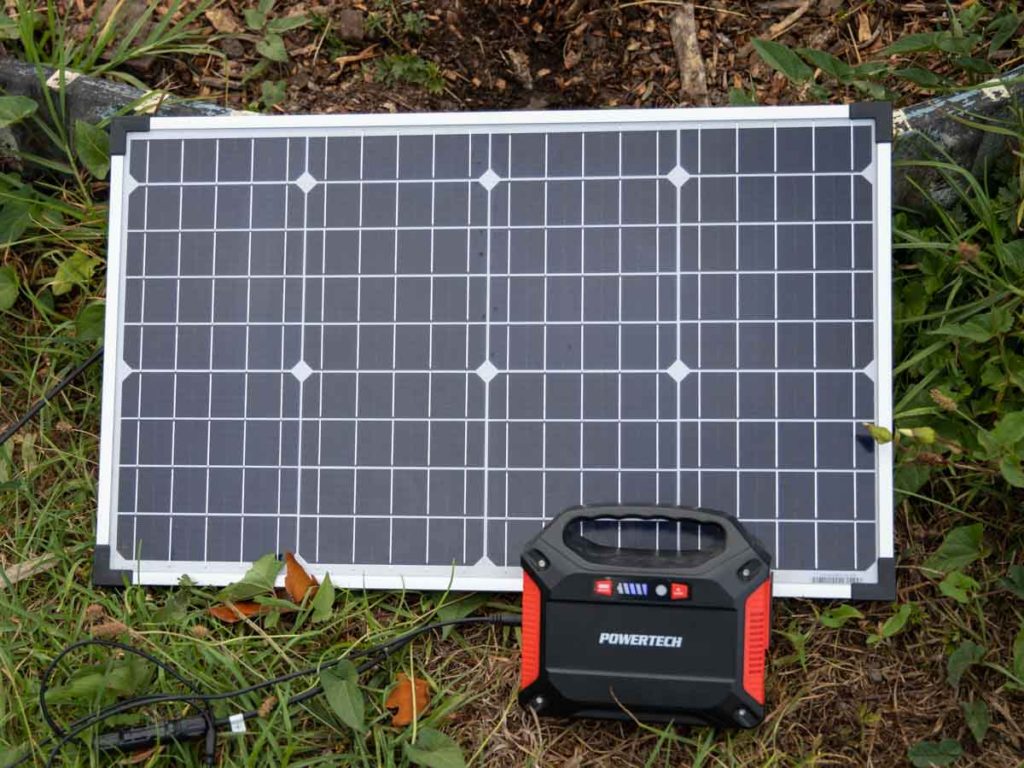
- If your van doesn’t come with a second car battery, the easiest and cheapest solution we found was to get a portable battery and a solar panel. We didn’t want to put holes in the roof, so we just secured the panel inside while we drove, and took it out when we got to our camp spot. This worked really well, and we were able to charge our phones every night.
- Put some bleach in your grey water, otherwise it can start to smell after a while.
- Get some antibacterial wipes for cleaning surfaces and the sink: super useful for van life hygiene.
- If you’re on a budget and freedom camping, a great tip that took us forever to figure out is to separate showering from camping! It’s easy to find a shower for $4, and then go camp for free. We would try to freedom camp for as long as possible without showering and then pay for a holiday park just to shower… totally unnecesary!
- On the note of paying for a shower, the public pools in New Zealand are awesome!! Most have hot tubs, and we loved going for a couple of hours on a cold day. And then there’s showers afterwards! Entrance to a public pool was usually around $7.
- Always check under the van before driving off! Many shoes have been lost this way in the history of campervanning.
- This is a weird one, but go pee at night! Sometimes it was dark and cold and I’d hold it until morning, and this is TMI already so just go pee!
Campervan Organization Tips
- Make sure things you use every day are easily accessible: every day clothes, toiletries, lighter, wine… the essentials!
- Store things that you only use occasionally in all the far away and inconvenient places. Backpacking backpacks, tent, sleeping bags, etc.
- Strap everything down with rope and bungie cords.
- Cords strung up high close to the ceiling are great for hanging clothes to dry if it’s raining, or on the road.
- Keep things organized and put away, and sweep every day. Living in such a small space can get really obnoxious if everything’s a mess.
Campervan Kitchen Storage Tips
- Have plenty of storage for food and kitchen equipment. This is not a place to scrimp on space. Fresh fruits and veggies take up a lot of space, but good fresh food is an essential part of making living in a van sustainable.
- Have a spice shelf! It’s not only super useful for organization and easy access, but visually pleasing!

Campervan Cozy Tips
- Fairy lights are essential! They actually provide enough light to hang out in, and are fundamental for coziness.
- The first thing we got for our van was a memory foam mattress topper, and OMG! Our bed was heaven. When we visited friends, we chose to sleep on our bed rather than the couch. Hostel beds became torture. You get the idea. If you’re going to spend months or more sleeping in a campervan, make it count.
- Blackout curtains are a must. We’ve slept in parking lots and felt cozy and safe inside. Even some holiday parks had bright kitchen lights infiltrating our eyelids, and closing our curtains sorted that immediately.
- A citronella candle is not only cozy, but repels mosquitos!
- A cute bookshelf adds a homey vibe, while also providing great storage.
- Adding some DIY decor really makes your van feel like home. I made macrame with driftwood we found, as well as a shell garland.
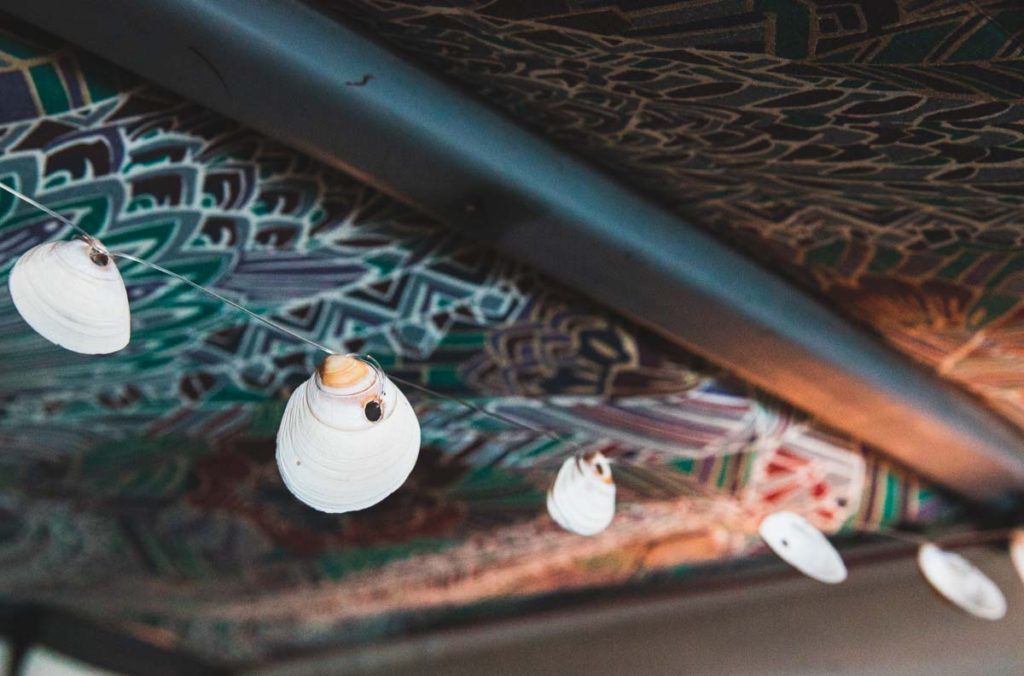
Final Thoughts
Campervanning in New Zealand was absolutely epic, but also pretty accessible for someone who’s never done anything like it before. There’s so many tools and resources available, including my blog! Please stick around to learn more, I try to provide comprehensive, detailed guides that come from my own experiences. Comment below if you have further questions!
